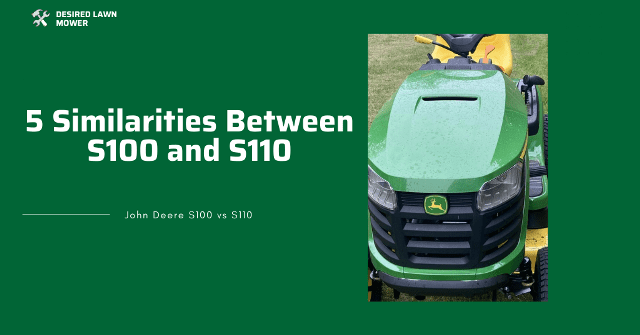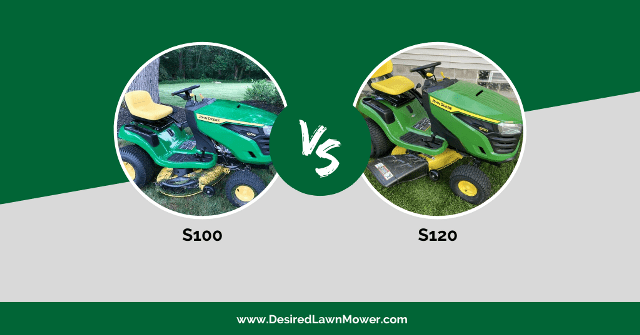The John Deere S100s are quite recent in their line of lawn tractors as they were introduced to the public in 2021 and have been thriving like champions in residential lawns and yards ever since. Compared to the previous series which is the E, the S100s showed up with a more futuristic design with few differences that confirms a better and easier mowing experience.
The S100 and the S110 are both at the beginner point of the whole series and they differ in a few elements that will apply to your mowing needs contrarily, which is why it’s important to fully understand their variations to ensure that you arrive at the model that will tick most or all of your requirements.
The John Deere S110 model has the upper hand in comparison to the S100 because of certain upgrades that are amplified on the model. If you have hilly or bumpy terrain, the S110 is definitely your mower. However, they are more expensive in comparison to the S100 which is also an aspect to consider relating to your budget. Although both of the lawn tractors do a good job, it’s always promising to personalize the debate so that you end up with the best option for you.
In this article, I’ll be discussing how the S100 and S110 differ so that you can discern which lawn tractor will be the most favorable for you in all jurisdictions.

5 Strong Differences Between The John Deere S100 & S110
You can either choose your riding mower based on the absence or presence of certain features. In most cases, a new or upgraded detail isn’t always the best scenario to suit your needs. Here’s what you’d be working with:
1. A Difference In Horsepower
The power of lawn tractors is one of the sharpest features of the whole machine and can easily be used as a yardstick for placing your final decision.
You’ll find that the S100s have a capacity of 17.5 horsepower in comparison to the S110 with 19 hp. While it’s always the best choice to choose the riding mower with more horsepower, there are a few cases where extra strength isn’t necessary. For example, if you mow a fairly featured lawn of about half an acre, then you’d be a-okay with the S100. Other than that, you’d be happier mowing with the S110 for the extra juice of 2 hp; slopes will be much easier to defeat, and wet or damp grass wouldn’t be that much of a threat.
You’d also be on the nicer end of using your S110 lawn tractor during the winter for snow plowing in comparison to the S100. If snow plowing with your lawn tractor is something you fancy, I can put you through all that is to know about the process via this article I have written: “Can You Plow with a Lawn Tractor“
2. Seating Features
This is more or less the first difference you’d notice if you find the S100 and S110 sitting side by side. On the S100, you’ll find the worst saddles imaginable! The one-piece seats are usually paired with low-end residential lawn tractors and they offer exactly nothing more than low-end comfort. You have little or no support for your back, zero ventilation to the rear area, and a ridiculous suspension system for tackling bumps as you mow.
Even worse, the plastic material used to make the seats will wear over time and crack to your dismay allowing water to seep in and cause more damage! I have tried to see the bright side of the one-piece seat but the aim always ends up defeated.
Thankfully, the S110 is equipped with much better seats. You’ll find the 15-inch two-piece seat with more comfortable and better quality padding. Although they are a more favorable option, they do get tiring if you sit on them for more than 2 hours. The best solution is to install a suspension seat on your lawn tractor, more especially on the S100. There is a wide variety of suspension seats for you to choose from and I have written an article about the best of the kind to make selection easy for you.
3. Engine Types
A lot of lawn tenders rely on engine types for a boost of confidence and reliability in the lawn tractor they seek to buy. For the advantage of familiarity, both models are equipped with Briggs & Stratton engines.
The S100 makes use of a one-cylinder engine in comparison to the S110 with the V-twin cylinders. The upper hand you’d get with a single-cylinder motor is that less fuel is consumed during your activities in the yard. However, V-twin cylinder engines are much more efficient and reliable.
The fuel intake and efficiency of both engines match the horsepower of the motors, so it’s safe to say that each model is adequately fueled to fit the size and features of your yard. If your yard is under 1 acre, the S100 will supply you with enough power and consume less fuel in the process. If you mow over an acre, you’d consume more fuel with the S110 but be sufficiently powered for the task.
4. Transmission System
The transmission unit of both models differs based on both functionality and brand. For the S100, you’ll get a Kanzaki Tuff Torq hydrostatic double-wheel transmission. On the other hand, the S110 is equipped with a Tuff Torq TL200– also a hydrostatic 2-wheel transmission. In terms of efficiency, the S110 tranny unit is much tougher in comparison to the S100; maneuverability is smoother, and climbing slopes is easier to achieve. Added to this, they will perform better in challenging mowing situations like mowing tough turf or wet grass.
Regardless of being the better option, both models’ transmission units are still not the best and will equally flunk if you overstress either of the machines. Some might even argue that the performance of the transmission units is just the same, but the S110 will endure much better than the S100.
5. Pricing
There’s a few hundred dollars difference between the two models; for the S100, you’d budget for $2000 – $2,200 in comparison to the S110 which costs about $2,400 – $2,600 respectively depending on your dealer.

5 Standard Similarities And Key Features Of The John Deere S100 And S110
The similarities between the two models are striking! Nevertheless, here are the major likenesses that can influence your decision-making:
PTO Switch
The PTO switch is responsible for engaging and disengaging the blades of the lawn tractor. Both models come with a manual PTO lever that requires you to horizontally swerve left or right to engage or disengage the blades.
For a good comparison, the S130 model and upwards make use of electric PTO switches in the pop-up button format that allows you to push or pull to operate the blades. One great advantage you’d have over the electric PTOs is that the manual operators last longer; the electric ones would demand replacement starting from three years of use– that’s just how it is.
Speed
The velocity at which both lawn tractors run in this case is not dependent on their different engine types or transmission, because you’ll find the speed to be the same.
The S100 and S110 both run at a forward speed of 5.5 miles per hour and a reverse speed of 3.2 mph. You’d be able to mow an acre in 1 ½ hour depending on if you have features like slopes and obstacles. The bonus side to this average speed is that the cut will come out cleaner, much better than they will if you are running at 8 or 9 miles. In cases like this, less is more.
Traction And Tire Size
The tire size for both the S100 and S110 is 15×6-6 inches at the front and 20×8-8 inches at the rear. This number screams how basic the traction is. Anything above 13 degrees is a sour joke for both models and could end in an accident. However, you can tweak the tire pressure to your advantage to help you tackle slopey scenarios if your yard is full of ups and downs.
Deck Type, Size, And Cut Quality
The deck size and type for both models is the standard 42 inches edge 13-gauge stamped steel deck. The decks are equipped with only 2 anti-scalp wheels and they cut surprisingly well; they leave no stragglers, turf tearing, or uneven cuts when you whizz by which is also due to the bulls-eye tow-mode speed of the lawn tractors. Although the decks are not so fancy or sophisticated, they do the work remarkably and will save you the stress of going over mowed spots.
Warranty
The S100 and S110 lawn tractors share the same residential grade warranty; a 24-hour/2-year bumper-to-bumper warranty for you to benefit from. Although I have to say, you wouldn’t be needing it much because of how durable the John Deere tractors are. If the mowers are maintained properly, they last as long as possible without any major complications.
Frequently Asked Questions About S100 and S110 Lawn Tractors
Can I Tow With My John Deere S100 Or S110?
You can tow anything with your lawn tractor as long as it’s in the capacity of your mower. Bear in mind that the transmission system isn’t the toughest in the market and would require you to attach basic items for towing or pushing so that you don’t overstress your machine.
What Is The Towing Capacity Of The John Deere S100 Or S110?
The towing capacity of your JD model is 400 Ibs and nothing more. It’s even much preferable to tow around 350 lbs to ensure your mower lasts as long as it should.
How Long Does John Deere S100 Or S110 Lawn Tractors last?
Your John Deere S100 or S110 will last anything from 8 – 9 years if maintained properly.
Can I Plow Snow With My John Deere S100 Or S110?
It’s very possible to go snow plowing with your JD lawn tractor as long as you don’t push or drag snow that is over the towing capacity of the mower. Simple driveway “snow shoving” will do just fine to preserve the lifespan of the lawn tractor.
The Conclusion
The S100 and S110 are both durable and efficient residential-grade lawn tractors that will serve their purpose well. However, if you’re seeking to purchase the better model, it will be the S110 because of its extra properties and strength. I strongly advise you to consider your requirements; you might even find the S100 sufficient enough for your needs and proceed to save money if you purchase them instead. All in all, I wish you good luck in your adventure!
